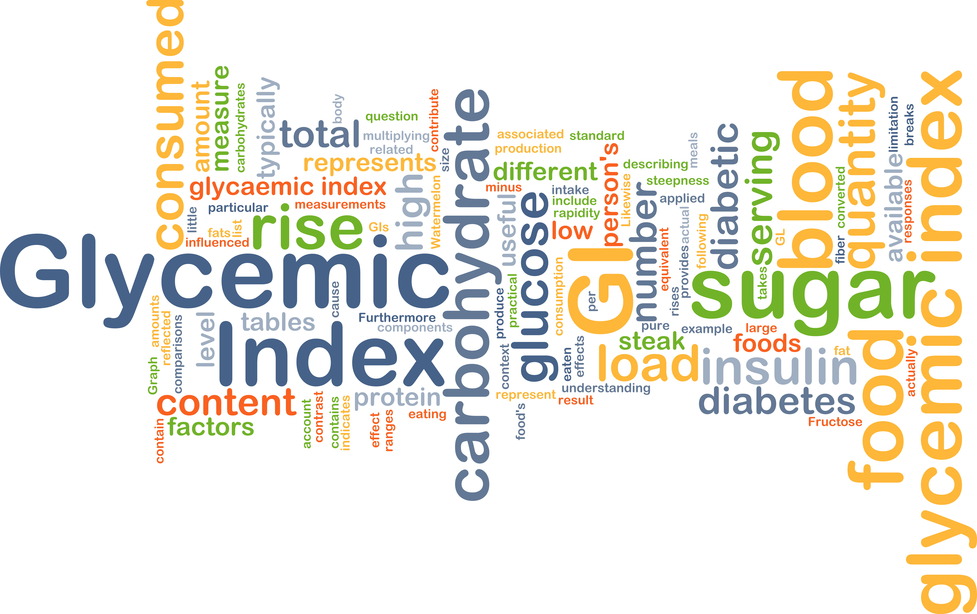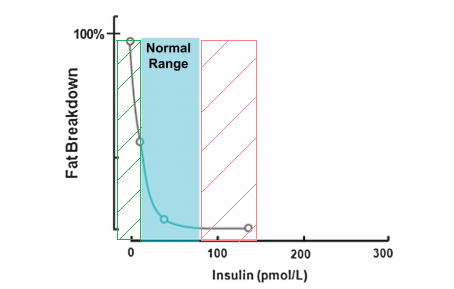
All food is digested in different ways in our body and has various impacts on blood sugar level. Fortunately, knowing the glycemic indexes of foods, we can easily control blood sugar level and therefore keep ourselves fit and healthy.
The glycemic index (GI) is a number that shows how a particular food affects a person’s blood glucose level. The values of GI range from 10 to 100; a lower GI number represents a low response of blood sugar level to a certain food, while the higher GI numbers mean a high response. In other words, green vegetables have a very low sugar content and increase sugar blood levels only slightly; therefore, their GI is very low (around 15). In a healthy low-carb or low-GI diet, you should choose foods with a lower GI and avoid those with a higher one. The value of 100 is considered standard and is the equivalent of blood glucose response to the consumption of pure glucose. The higher the GI number, the greater the blood sugar response is (blood sugar level and blood glucose level are synonyms).
It is agreed that the foods with a GI above 70 are considered high-GI foods, while those with a GI between 56 and 69 are medium, and all with a GI below 55 are low-GI foods.
The foods that have high glycemic indexes are those that are broken down in the intestine quickly, causing the blood sugar level to rise rapidly. The complex carbohydrates in foods rich in dietary fiber usually have much lower glycemic indexes since their digestion process lasts much longer, causing a limited blood sugar level rise. Therefore, refined complex carbohydrates such as white bread will have a high GI.
The golden rule to follow would be choosing non-refined products, such as brown rice, over white or sticky rice, hulless barley over pearl barley, or whole-meal spaghetti over white spaghetti—and if they are boiled for only a short time (called al dente), their GI will be even lower.
Unlike high-sugar products, many foods high in fat or protein do not cause a rise in blood sugar level. Instead, they may have an influence on the insulin index.
While the glycemic index gives information about how fast the blood sugar level rises (in other words, how fast particular food turns into glucose and gets into the bloodstream), it doesn’t tell how much of carbohydrate is in a serving of particular food. This information gives glycemic load.
Glycemic load (GL) gives a fuller picture of the impact of food on blood sugar level than GI does. While GI gives only an idea of how fast the peak of blood sugar occurs, it doesn’t say anything about how much sugar is in the food. GL combines those two important details. In other words, glycemic load is calculated based on the glycemic index multiplied by the content of available carbohydrates in grams in a standard serving. For example, many types of sweet fruit have a high GI but since there is not much sugar in them, their GL is relatively low.
It is agreed that a GL of 20 or more is high, a GL between 11 and 19 is medium, and a GL of 10 or less is low.
GI and GL and daily recommendation are presented in the table below:
| Glycemic Index (GI) Range | Glycemic Load (GL) Range | Glycemic Load per Day |
|---|---|---|
| Low GI = 55 or less | Low GL = 10 or less | Low GL < 80 |
| Medium GI = 56-69 | Medium GL = 11-19 | High GL > 120 |
| High GI = 70 or more | High GL = 20 or more |
So, in general, we should choose food in such a way that an average GI is around 50 and 55, and the total GL does not exceed 80. In order to achieve this goal, you may refer to the below tables while composing your meals and you may use the few simple rules below.
- Low GI doesn’t mean that the food has no carbohydrates at all.
Many people who eat a low-carbohydrate or a low-GI diet believe that as long as the content of carbohydrates is low, they can eat as much as possible. This is not true, as we require a balanced diet with carbohydrates, proteins, and fats. So first, make sure you know your proportions—how many nutrients you can eat in a day, how much salt and fiber, etc. You can read more about daily nutrient recommendations here. If there are any other recommendations, from your GP, for example, you should take that into account as well. - In general, foods that have sugar in the ingredient list will have a higher GI than those without added sugar. Whole grains and whole-meal bread and cakes have a lower GI than white bread and refined grains, so it’s better to choose brown rice than white. Same with bread, crackers, and pasta.
- Choose under-ripe fruit overripe fruit, especially bananas. Cooking under-ripe bananas will give the same effect as the ripening process.
- In general, foods high in fat or protein (or both) have a low GI.
- The great majority of vegetables (as well as forest fruit) have a very low carbohydrate content. If the food contains less than 5 grams of carbohydrates in a 100-gram portion, it may be considered free food and can be eaten in large amounts.
- Proteins and fat in complex meals have only a small effect on the blood glucose level.
- There are different types of certain staple food such as rice or potatoes. Their GIs differ a lot e.g. sticky or sweet rice has the highest GI, while other types have a lower glycemic index. Some differences may be found between different types of potatoes, so it’s worth checking the GI in a food index in order to choose wisely.
- Cow’s milk has a higher GI than soy milk, as it has more available carbohydrates per serving. But this is not true for all types of soy milk, as some of them may have a much higher level of carbohydrates than cow’s milk. It is better to read the label and choose brands that have only up to 5 grams of carbohydrates per serving.
- Cooking may increase the GI of some foods—for example, a raw carrot has a GI of 20, while a cooked carrot has a GI of 50.
- Cooking time may change the GI of pasta drastically. Al dente spaghetti (5 min cooking) has a GI of 40, while prolonged cooking (15 min cooking) increases the GI to 70. Dry or toasted bread has a lower GI than the fresh one.
- Cooling food after cooking will decrease its GI, so it is worth cooking pasta the day before and cooling it if you are planning a pasta salad. However, it has to be stored without anything added, especially lipids. The same applies to lentils and grains. Reheating foods after cold storage will decrease the GI even further.
- Steam cooking contributes to a lower GI than immersion cooking.
- The higher content of fiber, the lower the GI; therefore, it is good to begin dinner with a salad as a starter.
- Storing vegetables (like potatoes) increases GI. Therefore, freshly harvested potatoes have a lower GI.
- The smaller the particle size, the higher the GI; wheat coarse flour has a lower GI than refined white flour, as the coarse type is rich in fibers and proteins, which lower GI.
One of the fullest lists of foods with GI and GL can be found here:
http://www.menhttp://www.mendosa.com/gilists.htm
Glucose
Glucose is the basic source of energy for every cell of our body, but it can become the cause of many diseases if overeaten.
When we consume carbohydrates, they are broken down into their simplest molecules: glucose and fructose. Those two are digested in a totally different way. Glucose serves as an energy source and can be metabolized in many different cells, while fructose goes straight to the liver and is transferred to fat.
Here is a more detailed analysis of what happens to glucose in our body.
The priority metabolism of glucose is direct glucose oxidation (which is using glucose as fuel without storing). When this need is met, glucose is transformed into glycogen and stored by the liver and skeletal muscles.
Direct oxidation uses 20-25 grams of glucose while we are at our resting state (the majority of the time). In other words, the oxidation daily need is low. By following a typical unhealthy diet that is rich in carbohydrates (bread, pizza, pasta, etc.), we supply more glucose than we can oxidize, so the rest which is not oxidized is transformed into glycogen in the liver and muscles. However, the glycogen storage limit is low—approximately 400 kcal (120g of glucose) in the liver and approximately 1,200 kcal (400g) in the muscles. Those numbers depend on the size of a person, food intake, sports activity, lean muscles, and body fat percentage.
What happens to the rest of the consumed glucose which is not immediately metabolized or turned into glycogen? It is transformed into fatty acid and stored, for example, as “belly tire” fat. This transformation is irreversible. The fat cannot be used as easily as glycogen; it has to be burnt during exercise or used up while dieting.
Eating too many carbohydrates and sugars contribute to the production of body fat. However, there is another important issue related to elevated sugar level: the more sugars you eat, the more insulin is produced, and elevated levels of insulin decrease the ability to burn fat and increase the capacity to store fat.
The green box in the plot below represents a low-carb diet, which demands low levels of insulin and therefore promotes fat breakdown to produce energy, while the red box represents a high-sugar diet that generates high levels of insulin and promotes fat storage and carbohydrate breakdown. Overall, a high-sugar diet promotes fat storage and contributes to many serious diseases in the long term.

Source:
Jensen et al, Insulin regulation of lipolysis in nondiabetic and IDDM subjects. Diabetes 38: 1595–1601, 1989.
Keith N. Frayn Metabolic Regulation – A Human Perspective, 3rd edition, 2010, Wiley Blackwell